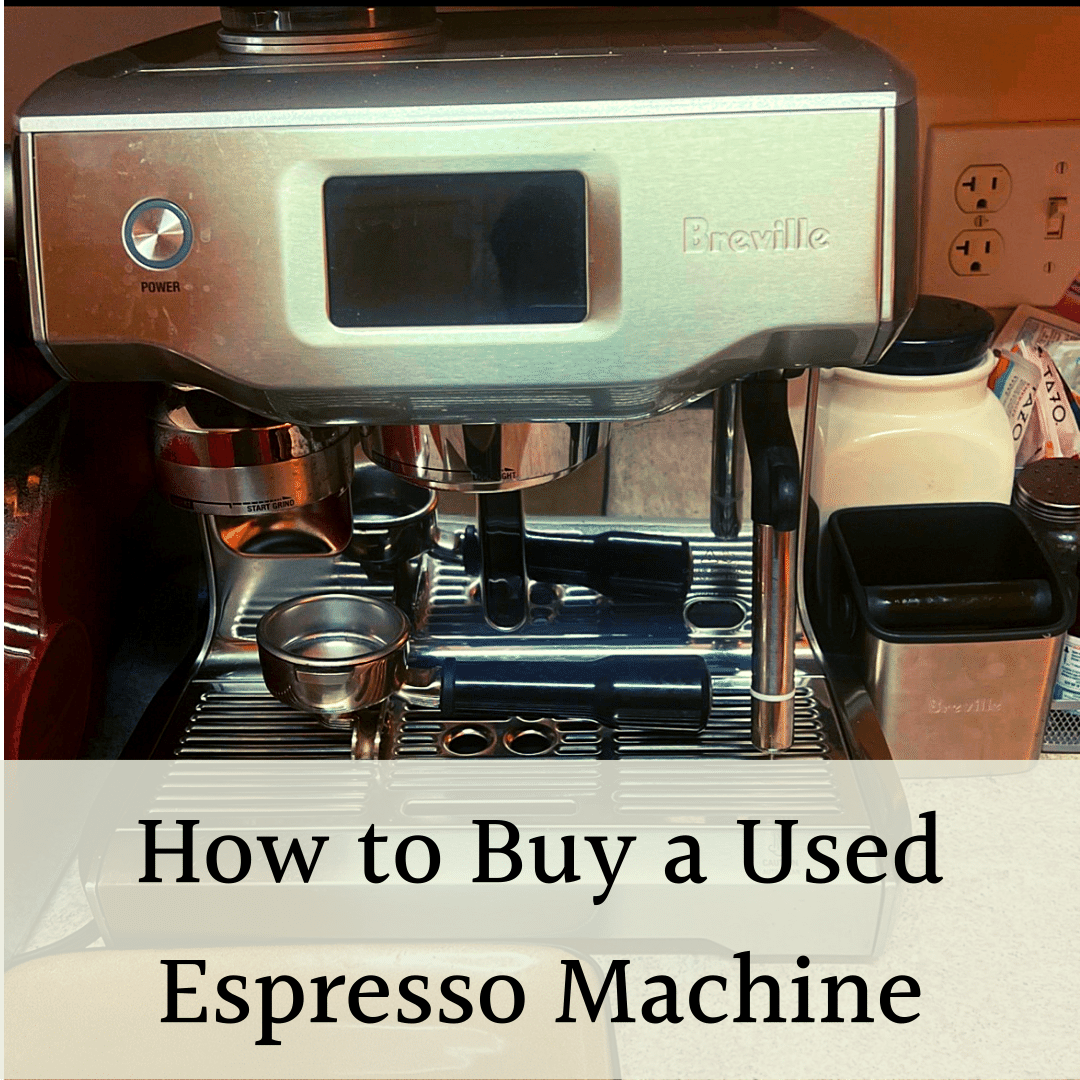Choosing your first espresso machine can be overwhelming with terms around heating systems, bars of pressure, and steam wands.
I want to simplify the choice with eight beginner espresso machines focused on ease of use, quality, and price. My top three espresso machines for beginners are:
- Breville Barista Express Impress — a very intuitive machine that any beginner can learn quickly
- Breville Bambino — Great heating system and a straightforward design with no frills (at a great price)
- Gaggia Classic Pro — our advanced pick for those who want a higher potential and will deal with a learning curve.
This article combines our work across 50+ espresso articles at Craft Coffee Spot to help beginners choose their first espresso machine. I’ll explain why these are my favorites and how to choose.
Types of Espresso Machines
Espresso machines are divided into three categories, which I’ll summarize briefly:
- Manual: You have to do everything to make espresso, including adding hot water, ground coffee, and apply pressure.
- Pros: full control over the outcome and typically lower price.
- Cons: lot of work to master.
- Semi-automatic: The machine forces hot water through the finely ground coffee at high pressure. You need to prepare the coffee to varying degrees, and the machine may or may not have a grinder.
- Pros: best balance of quality espresso and ease of use.
- Cons: lots of options and still requires effort to prepare.
- Super-automatic: The machine does everything with a push of a button. You add whole coffee beans, and that’s it.
- Pros: foolproof operation.
- Cons: Expensive and lose some espresso quality with limited settings.
I’ll focus on semi-automatic espresso makers today because they give the best combination of quality, ease of use, and price for a home espresso newbie. They are also the most common espresso machine.
I will include a few options for super automatic and manual espresso machines too. But, if you really want to go down that path, read our guide on super-automatic espresso machines and manual espresso machines, respectively. It’s a different persona for those.
How To Choose Your First Espresso Machine
Before you settle on what machine to buy, you should know what to look for. There are great semi-automatic and super automatic espresso machines, good ones, and sub-par ones…and the price tag doesn’t always guarantee quality!
Here are the key features you should put on your checklist:
| Beginner Espresso Machine Checklist | Criteria |
| Built-in grinder | Choose one with a built-in grinder if you don’t have a burr grinder |
| Heating system | PID controller is important for thermoblock machine; boiler or dual boiler is better but expensive |
| Pressure | Must generate consistent 9 bars of pressure |
| Milk frothing | Manual steam wand or automatic milk frother depends on work you want |
| Ease of use and cleaning | Simple design = easier morning |
Budget
First, a word on price. Espresso machines go from a couple of hundred dollars to several thousand dollars. A general rule is that you get what you pay for. Super-automatic espresso machines have a lot of technology inside, so these are among the most expensive espresso machines you can get.
This article focuses on models that cost under $1,000. I strongly believe beginners should avoid spending more than that. There are diminishing returns to more spending and the machine doesn’t get easier to use either.
Last, a home barista’s skill will often trump the price of the espresso machine. One of my favorite coffee videos is the contest between a barista with a budget machine and a layperson with a commercial machine (spoiler: skill matters).
I encourage learning how to make espresso first with something at a reasonable price. You can always trade up for a more premium machine (or grinder) when you know what you want.
Pressure
Pressure is crucial for the success of your espresso. In fact, high pressure is the central concept behind what is espresso.
The best espresso machines use a pump that generates pressure. Some cheaper espresso devices use steam to generate pressure, which is a worse option because it makes the pressure level uneven and unpredictable.
Choose a machine that generates nine bars of pressure, which brews the most balanced espresso shots.
Some manufacturers will advertise much higher pressure, going up to 19 bars of pressure! Don’t be fooled by these claims, as higher pressure isn’t always better. The key is consistent pressure; my recommendations include models we know and trust.
Some machines, like the Breville Barista Express Impress, have a pressure gauge to give real-time feedback on the pressure level. This allows you to dial in your grind size and ensure you’re pulling a proper espresso shot.
Heating System
You can go down a rabbit hole researching the differences between different heating methods and boiler configurations for home espresso machines. We go into detail on espresso machine internals, but generating consistent, high temperatures matters the most.
Consistent water temperature is key for even extraction. That’s why you need an espresso machine with a proportional integral derivative (PID) controller. In other words, PID controls the heating element, keeps the temperature stable, and lets you change the temperature in single-degree increments.
The PID is connected to the heating element and makes sure the temperature doesn’t fluctuate and keeps the thermostat system accurate. It smoothes out temperature fluctuations like the graphic below:
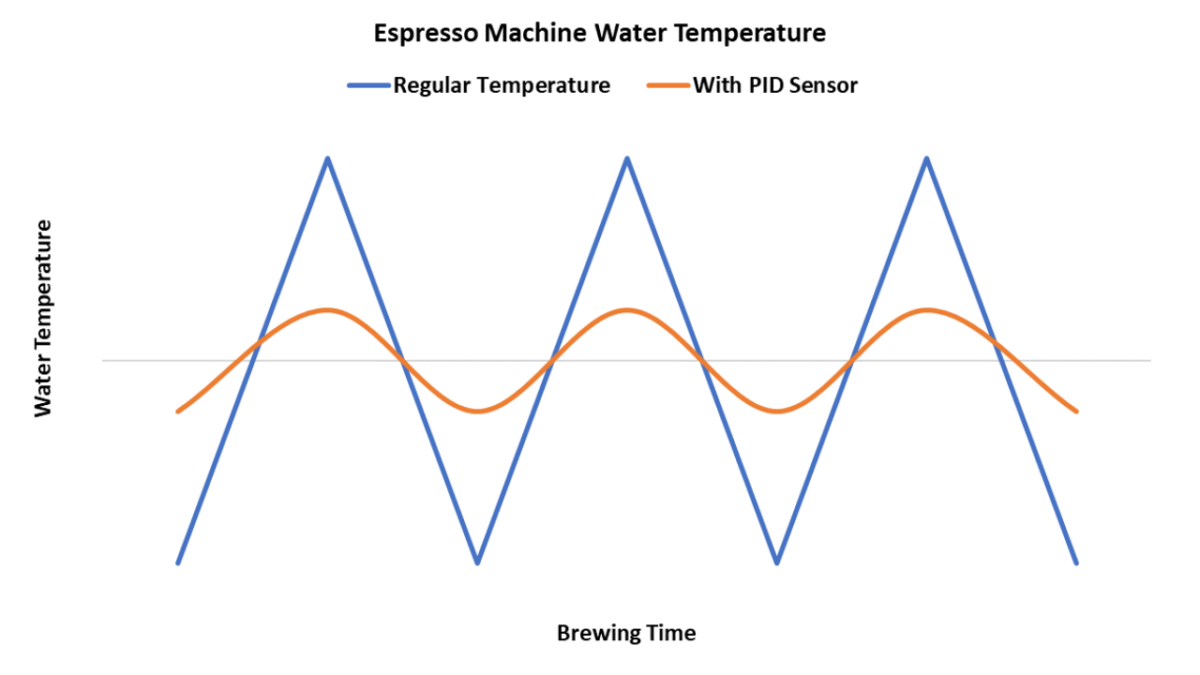
As for the heating system, you have a thermoblock, boiler, or a heat exchanger. Most of my suggestions are for thermoblocks, which heat water with a big metal block with thin piping. These are less accurate, but can do quite well when combined with a PID controller. A plus of thermoblocks is the fast heat up time, so you don’t have to wait more than a minute for espresso in the morning
Boilers and heat exchanges have bigger reservoirs, which lead to better temperature stability. But, they take longer to heat up, are larger, and more expensive. Some of my recommendations have these, like the Gaggia Classic Pro, but you need to splurge for a nice boiler model.
Then, there are single and dual heating systems. Single-boiler (or thermoblock) espresso machines use the same boiler for heating water for the espresso shot and the steam wand. This means some wait time for the boiler to transition between the temperatures. However, the technology has advanced enough that there’s very little wait time between these steps, even on single thermoblock machines.
Dual-boiler machines let you pull the shot and steam the milk simultaneously. However, these machines are expensive (think $1,500 plus). You’ll find these boilers on higher-end super-automatic machines.
If you’re looking for an espresso machine for beginners, you probably don’t need a dual-boiler. Plus, most single-boiler machines nowadays are pretty advanced, and you don’t have to wait long between brewing and steaming.
Milk Frothing
Home espresso machines for beginners can have two milk frothing options: steaming the milk manually or automatically. Automatic frothers are usually in the form of a carafe that you attach to the machine as needed. These are more common with super-automatic machines. The machine automatically dispenses the required amount of frothed milk into your cup.
Automatic milk frothers are great if you’ve never used a steam wand before and don’t want to go through the learning process. I included the Philips 3200 LatteGo on this list for that reason.
A manual milk frother is usually in the form of a steam wand. The wand shoots jets of steam into the milk through holes on the tip. The steam wand gives you more control when you froth milk. You can get different nuances between various milk-based drinks and work on latte art.
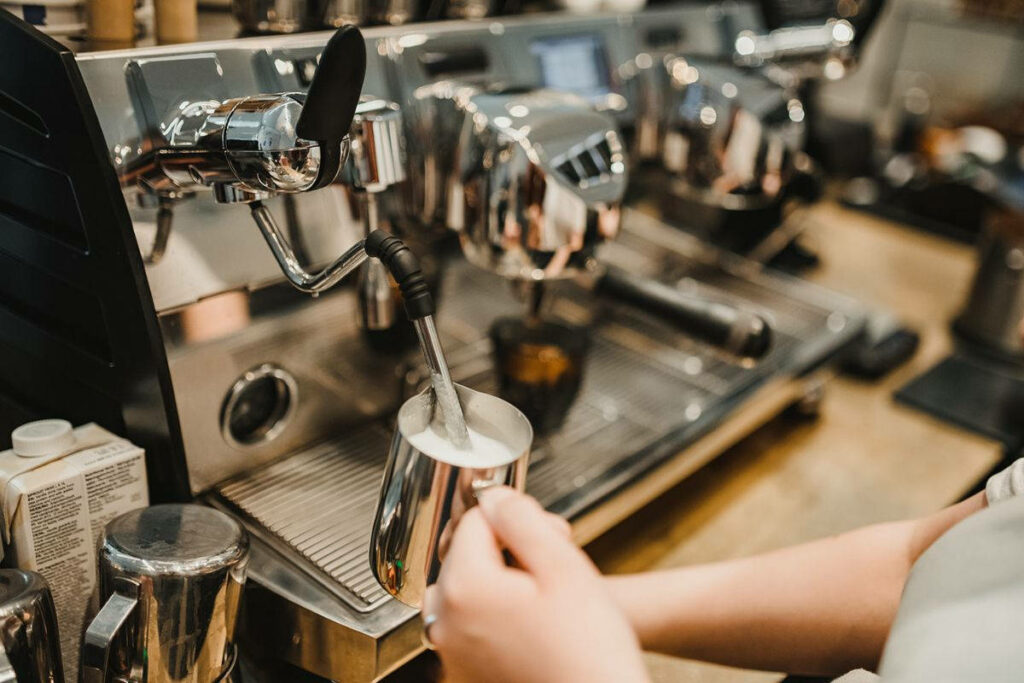
However, manual milk frothing requires going through a learning process: having an observant eye, using different pitcher angles, training your palm, so it’s sensitive to the milk’s temperature, and more. We have a guide on milk frothing and latte art to help.
Built-In Grinder Or No Grinder
Super-automatic machines are bean to cup machines, which means they come with a built-in grinder. On the other hand, a semi-automatic machine can come with or without a built-in grinder (most semi-automatic espresso machines come without).
The choice of a grinder or no grinder is a big decision with strong views on both sides.
A standalone grinder will often do a better job than a built-in grinder, since it’s designed solely for espresso by a specialized manufacturer. However, this also means more work in having two machines and transferring the portafilter back and forth. You’ll have to grind your coffee separately and set out more space for your espresso equipment.
Integrated grinders make espresso brewing much easier. Frankly, integrated grinders have led more people to get into home espresso because you can put your portafilter under the grinder and push a button.
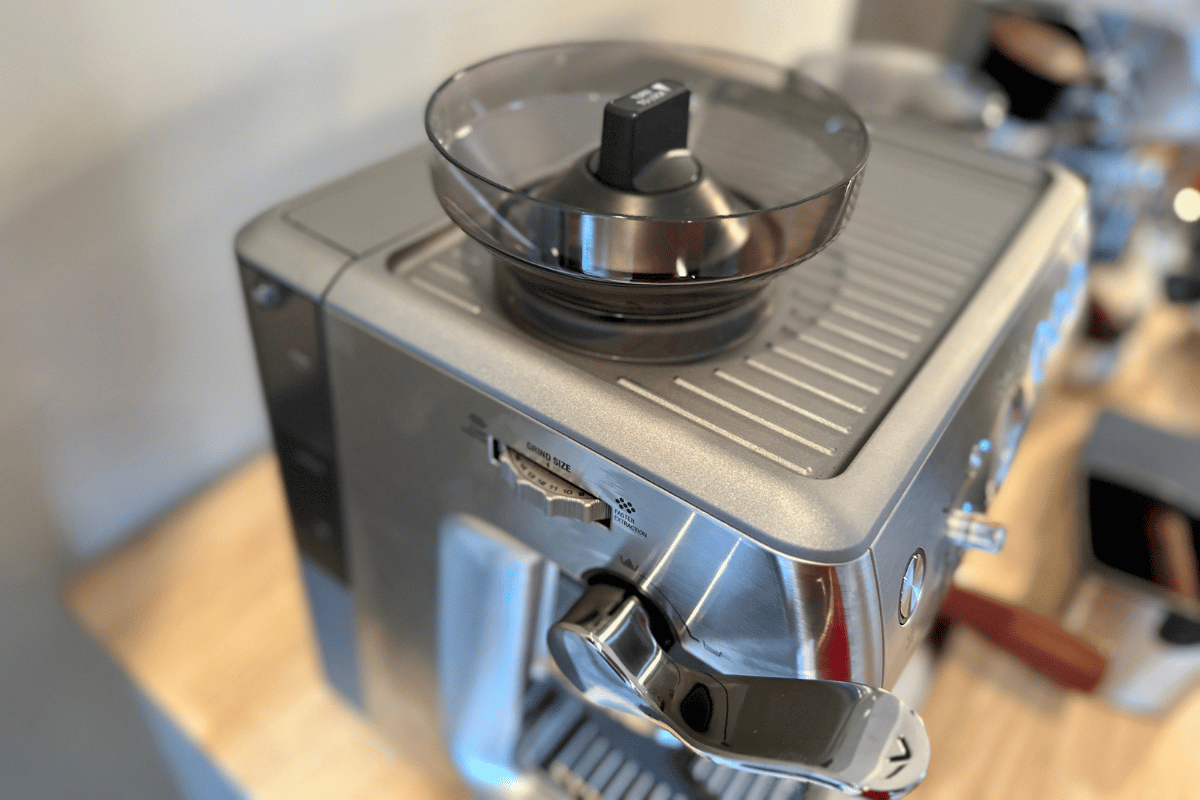
This is how the Breville Barista espresso machines work, and it’s easy! But, those grinders produce clumps, and you can get mixed sour and bitter shots. I noticed a big improvement just from upgrading my grinder. However, that was only after I mastered the machine first. I’m not sure I’d notice to start.
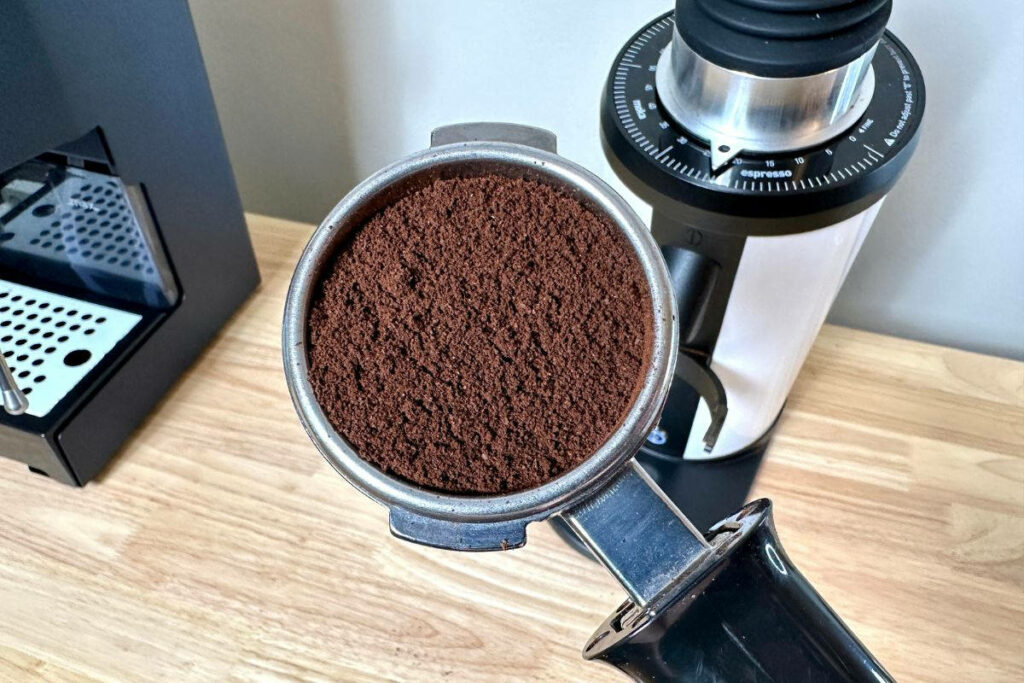
Either way, you need a quality burr grinder to make espresso. You can check our list of espresso grinders with options that easily pair with the semi-automatic models on this list.
Ease of Use
Be honest with yourself: how much knowledge do you already have on the brewing espresso process, and how much are you willing to learn? It’s no use getting a semi-automatic espresso machine if you can’t figure out how to use it or if you spend more time cleaning than using it. If you already know how to froth milk and dial in espresso or want to learn, go for a more hands-on machine.
On the other hand, if you want a machine that takes care of the whole brewing espresso process, get a super-automatic espresso machine. Many of these machines also have automatic cleaning functions. For example, a super-automatic machine self-cleans the steam wand and does a rinsing cycle after each brewed espresso, which means less work for you.
My list of top choices includes different types of machines.
Pro tip: Always check the manual or look for tips on how to clean your espresso machine. Also, go for a machine with accessible parts and fewer buttons, levers, and dials.
8 Best Espresso Machines for Beginners
| Image | Product Name | Features | Price |
|---|---|---|---|
Top Pick 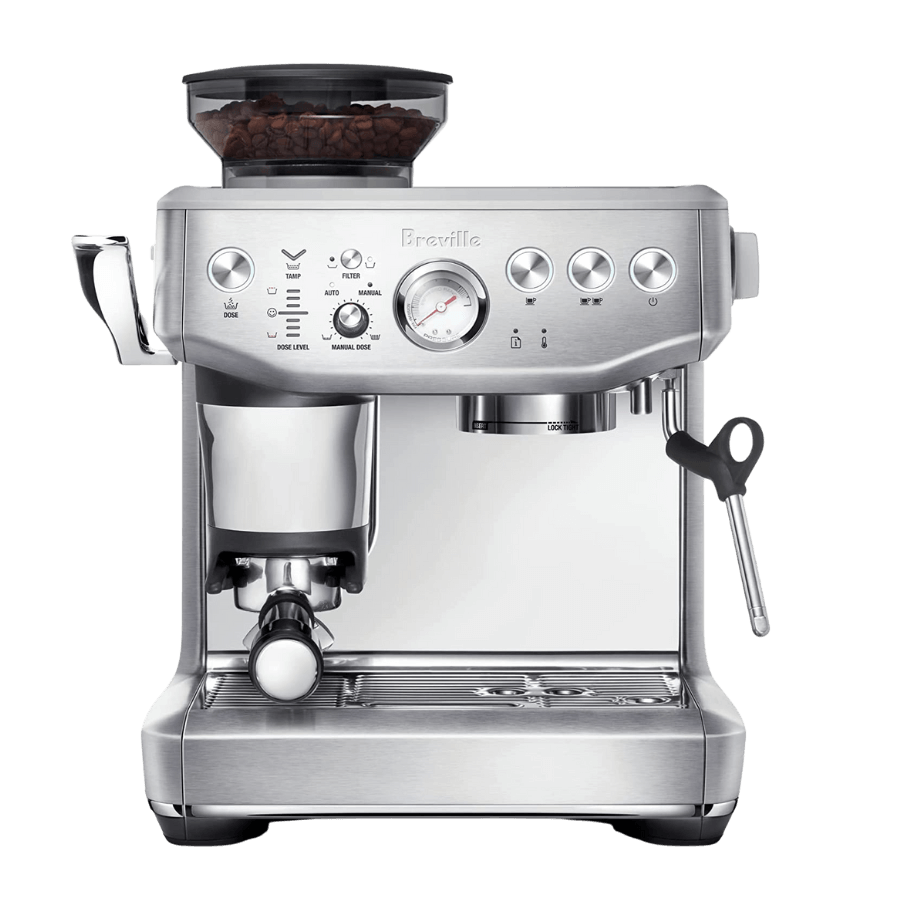 |
| Check AmazonCheck Breville | |
Runner Up 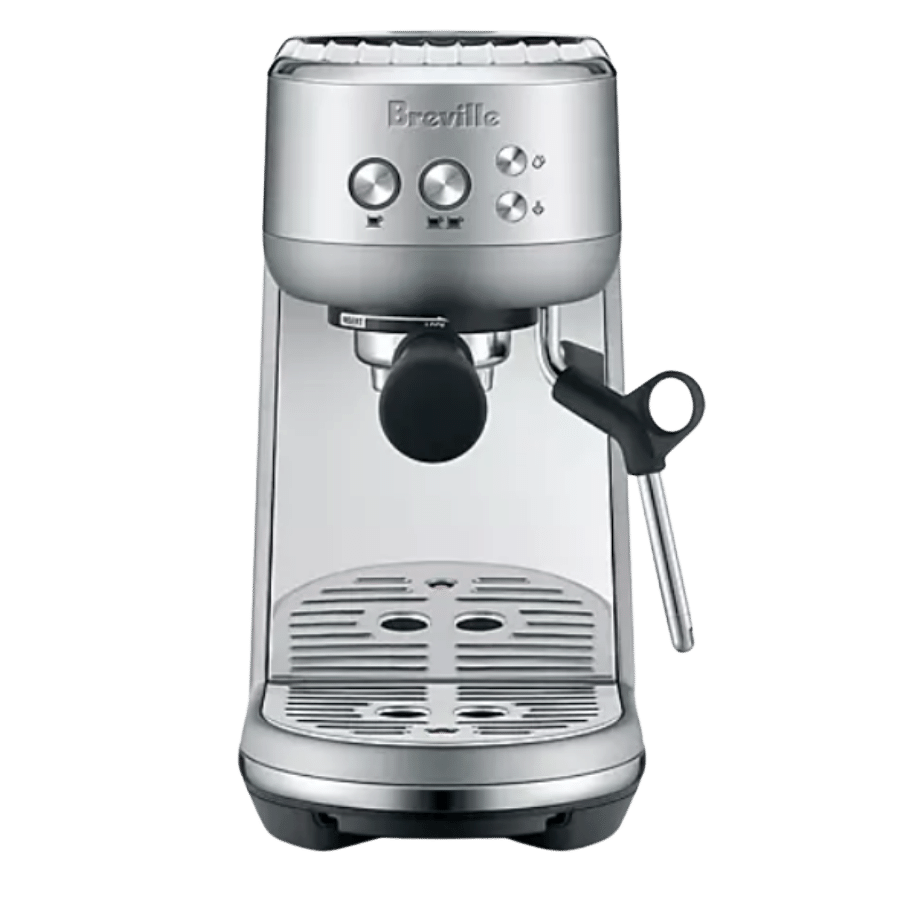 |
| Check AmazonCheck Breville | |
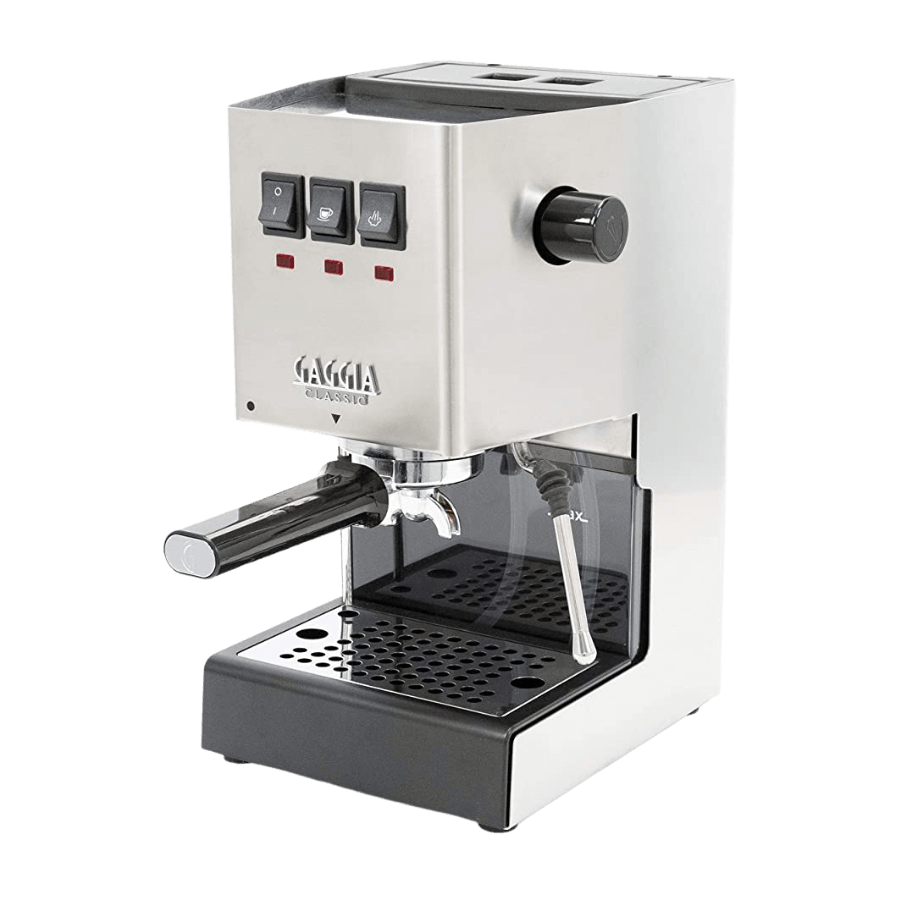 |
| Check Amazon | |
 |
| Check AmazonCheck Williams Sonoma | |
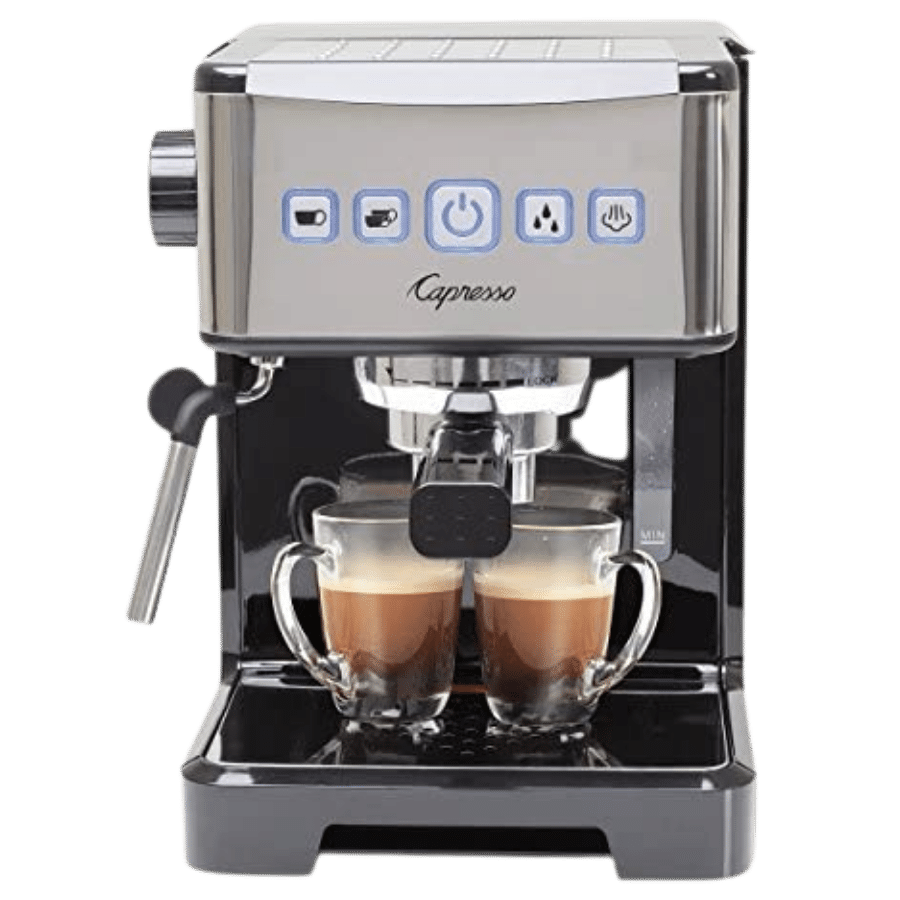 |
| Check Amazon | |
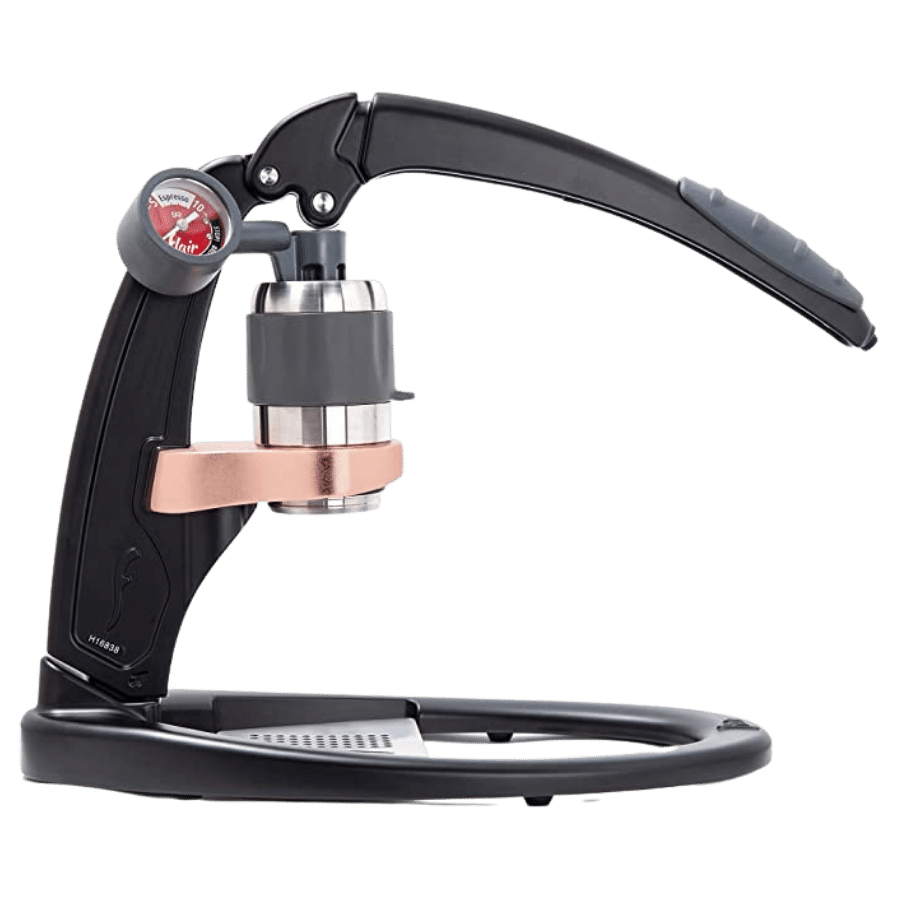 |
| Check Amazon | |
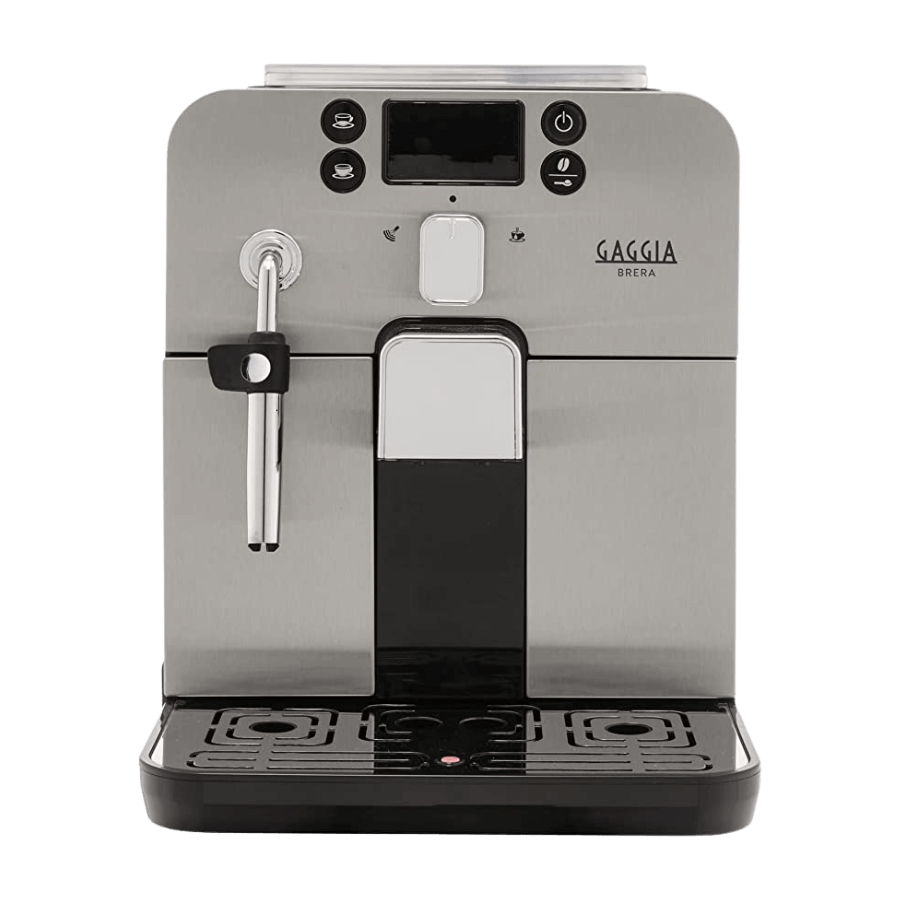 |
| Check Amazon | |
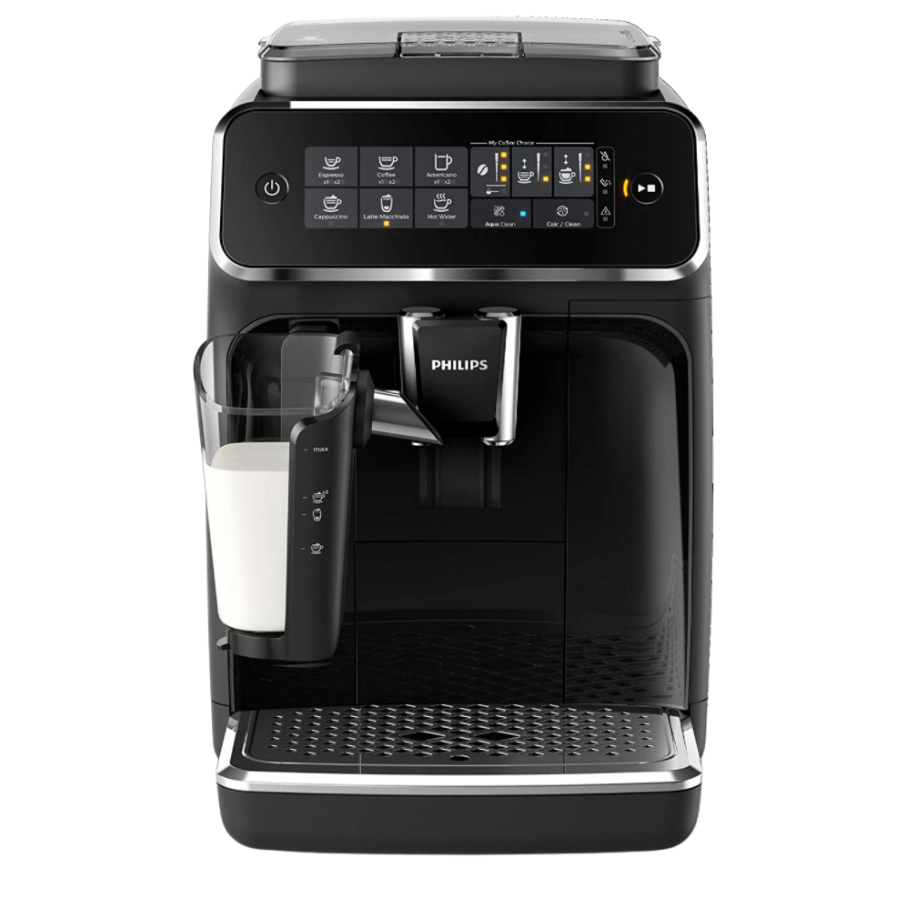 |
| Check AmazonCheck Seattle Coffee Gear |
1. Breville Barista Express Impress

Breville Barista Express Impress highlights:
- Semi-automatic machine
- Associated tamping
- Intelligent dosing
The Breville Barista Express IMPRESS is perfect for beginners entering the world of espresso-making. Its standout feature is the assisted tamping system. Normally, preparing a coffee puck requires meticulous attention to get the right amount of coffee, level it, and tamp it evenly. This machine simplifies all that. It grinds the coffee and allows you to prep the puck by pulling a lever—no guessing needed.
Another impressive feature is the intelligent dosing. If you’re new to this, measuring out the perfect amount of coffee beans can be tricky. The Impress takes care of it for you. The machine automatically measures the ground coffee and will adjust how much coffee is dosed if the current dose is too high or too low.
The preset one and two-cup settings are synchronized with the intelligent dosing feature. This ensures you get a standard 1:2 ratio of coffee-to-espresso, without any extra effort on your part.
Also, the Barista Express Impress operates at nine bars of pressure, which is lower than many espresso machines. Contrary to what you might think, lower pressure leads to more even espresso extraction.
However, the machine’s steam wand is a bit of a letdown. While it is integrated and easy to maneuver, it doesn’t generate sufficient pressure to create good microfoam. This is due to the older thermocoil technology inside the Impress. The thermocoil is weaker with more temperature fluctuations than Breville’s newer thermoblock, which offsets some other positives for espresso.
The Breville Barista Express Impress removes most of the complexity from the espresso-making process, making it an excellent choice for beginners. The only downside is the steam wand, but it’s a minor drawback considering the overall ease and functionality of the machine.
See our full review of the Breville Barista Express Impress.
Pros
Assisted tamping system
Dosing adjusts automatically
Preset shot volume for right espresso ratio
Cons
Steam wand lacks pressure
Thermocoil has worse temperature stability
2. Breville Bambino

Breville Bambino highlights:
- Semi-automatic machine
- No wait time between brewing and steaming
- Manual steam wand
Breville Bambino is also close to the top home espresso machine for beginners. The difference here is it has a better heating system, but is much more manual than the Impress, so it’ll require some work from you. Still, it’s a bargain with enough controls that an espresso newbie can handle.
The Bambino has Breville’s latest thermojet technology which gets the machine ready to brew in three seconds. Plus, there’s almost no wait time between brewing and steaming. The Bambino comes with low-pressure pre-infusion, which primes the ground coffee before brewing, so you have very precise espresso extraction. The PID provides temperature control for consistent shots at optimal water temperature.
Bambino comes with a manual steam wand that can create rich microfoam, which means you can practice your latte art skills. There’s a high learning curve, but the Bambino is nice because it has a one-hole wand. That’s slower (about one minute to froth) yet more forgiving as you have time to aerate and stretch the milk.
The brewing process is easy — choose between single or double espresso shots. You can program each option manually to dial in the shot by holding the button to start brewing and let go to re-program that volume.
Bambino is compact and doesn’t take up much kitchen counter space. The water tank pays the price for the compact size — it’s 47 oz, which is smaller than most other machines. However, it’s still a good size, considering how compact the Bambino is.
The Bambino doesn’t have a built-in grinder, which is understandable considering the affordable price. You’ll have to get a separate grinder, which means you’ll need to allocate more space in your kitchen.
See our full comparison of the Breville Bambino and Bambino Plus.
Pros
Compact size
Fast heat-up time
Easy to use
Affordable
Cons
No built-in grinder
Plastic tamper
3. Gaggia Classic Pro

Gaggia Classic Pro highlights:
- Semi-automatic espresso machine
- 72-ounce water reservoir
- Commercial portafilters and steam wand
Gaggia Classic Pro has a stainless steel body, commercial steam wand, and a 58mm portafilter, which you usually see on commercial espresso machines. Where most other machines have a 54mm basket, Gaggia Classic has 58mm, so you can add more freshly ground coffee and have a larger puck, which allows more even extraction across a larger surface.
Gaggia Classic Pro has a single boiler. This leads to better temperature stability, but it needs five minutes to heat up. Once it’s ready, it steams in only 30 seconds. Plus, you can pull several shots one after the other, which is useful if you’re making drinks for several people.
This machine has three buttons that tell you when the device is ready for use. The water tank is 72 oz, which is the largest on this list, and you can brew several drinks without refilling.
Gaggia’s steam wand can easily achieve high pressure, thanks to the two holes on the tip. The wand creates a good microfoam so you can create latte art. Finally, a cup warmer plate can keep up to five cups warm and always ready to use.
There is a learning curve here, which made me consider adding it to this list. There is no PID, so the water can get too hot if you want too long to heat, or not enough for too short. You need to feel out the right setting, known as temperature surfing. Also, the brew head is low, and it only holds short cups. Lastly, the steam wand holes point at different angles, which also make frothing tricky.
That said, you can get a really nice espresso if you are willing to learn. Also, the Gaggia Classic Pro is easy to open up and modify. The real adventurous can transform this into a very nice machine.
Pros
Cup warming tray
Commercial steam wand
58mm portafilter
72 oz water tank
Cons
Needs five minutes to heat up
Low brew group doesn’t fit many cups
4. DeLonghi ECP 3420
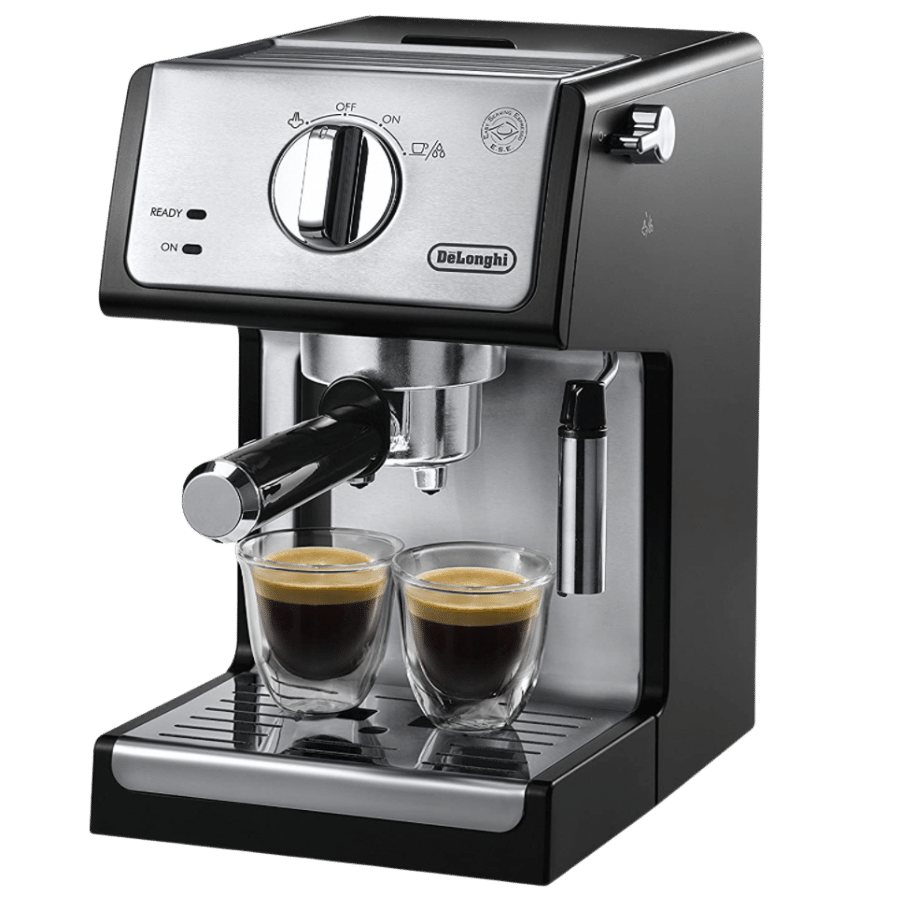
DeLonghi ECP 3420 highlights:
- Adjustable drip tray height
- Stainless steel boiler
- Rapid brewing system for brewing coffee cups in succession
DeLonghi ECP 3420 is a budget machine, so it makes sense that it has a plastic body with stainless steel accents. The plastic is ABS, and it’s durable, so you don’t have to worry about the machine’s longevity.
ECP 3420 uses a boiler system and has a fast heating time — it takes less than a minute to heat up from the start. It also has a rapid reheating system that allows you to pull several espresso drinks in succession or switch to steaming in 30 seconds. However, the boiler isn’t very powerful, so you must use a pressurized basket and coarser grind, limiting the flavor potential.
This machine has a 15-bar pressure pump that is powerful enough for an espresso machine with a pressurized portafilter. For the price this comes at, it is a very solid working model and I refer to this as a “starter” machine.
The steam wand is manual. It can heat the milk well, but it runs out of steam (literally) and is the weakest feature of this one.
I also didn’t like that the tamper and the portafilter are plastic, so I couldn’t get a proper puck in the filter. You’ll probably invest in stainless steel parts, plus a grinder. Even though this is an affordable machine, keep in mind you’ll want to make investments as your brewing skills grow.
Pros
Affordable
Rapid brewing system for pulling shots in succession
Small footprint
Removable drip tray
Cons
Steam pressure is insufficient for creating microform
5. Capresso Ultima Pro

Capresso Ultima Pro highlights:
- Automatic tamping
- Thermoblock heating system
- Single and double cup programmable buttons
The Capresso is one of our favorite budget machine options. The self-tamping portafilter is the feature all beginner baristas will love. Usually, you have to measure the grounds, load the basket, tamp the coffee, and load the portafilter. But, Capresso has a brew head above the portafilter that’s shaped like a parabolic disc. This brew head tamps the ground coffee when you lock in the portafilter.
This means there’s no need to get a separate tamper. Plus, tamping is crucial for a good espresso shot, and Capresso’s self-tamping portafilter lowers the chance of mistakes during the brewing process.
Capresso’s heating system is stainless steel lined thermoblock, which heats the espresso maker in less than 10 seconds. This goes for both steaming and pulling shots, so there’s a short wait time between the actions.
Usually, you have to stop the pouring on a semi-automatic espresso maker. That’s not the case with the Capresso. It’s an auto shut-off machine, so you’ll never wonder when to turn it off. You can also re-program the machine to stop at your desired water volume.
The 34 oz removable water tank makes refilling and cleaning easy. The water tank is on the smaller side, but you can make several espressos before refilling.
The manual steam wand allows Capresso to make single and double espresso shots and milk-based drinks. However, the Capresso’s steam wand is ok at best. It creates big bubbles and not foam, so there’s no fine foam for lattes.
Pros
Automatic tamping
Single and double shot options
Fast heat-up time
Automatically stops pouring
Cons
Fingerprint magnet
No removable drip tray
6. Flair Pro 2

Flair Pro 2 highlights:
- Manual espresso machine
- Simple and intuitive build
- Pressure gauge included
If you’re a beginner eager to roll up your sleeves, the Flair Pro 2 is the manual espresso machine we recommend. The upside of a manual espresso machine is how much control it gives you. You get to be the boss of your own coffee!
But remember, being the boss means more work. You have to pour hot water into the brew group, grind, and weigh your coffee.
What makes the Flair Pro 2 a good choice for beginners is the simple, yet sturdy construction. It has a strong base and the parts that make the coffee—called the brew head and lever arm—are easy to assemble. It even comes with its own travel case, so you can make good coffee anywhere you go.
A very feature that makes this accessible to anyone is the pressure gauge. If you’re new to manual espresso, getting the pressure right can be tricky. Think of the gauge like a cheat sheet; it tells you if you’re doing things right. The pressure gauge helps you adjust the grind size and dose. Still, you’ll need to practice to get that perfect shot of espresso every time, which is something I still work on with this model.
You’ll need a couple of extra things, like an espresso grinder and a small scale to measure the yield. You’ll love this machine if you enjoy being hands-on and controlling how your coffee turns out.
In short, the Flair Pro 2 is a fantastic option for beginners. It’s built well, gives you control, and helps you learn how to make great espresso. If you’re looking for more options, Flair has other espresso models like the budget-friendly Neo or the fancy Flair 58, which even heats the water for you.
Pros
Easy to assemble and disassemble
Pressure gauge helps dial in espresso
Convenient travel case
Cons
Small portafilter
Requires tools and a learning curve
7. Gaggia Brera

Gaggia Brera highlights:
- Stainless steel Panarello wand
- Rapid steam function
- Compact size
Gaggia Brera is the best super-automatic espresso machine for beginners and our favorite from Gaggia. You can press a button and have a quality espresso ready in less than a minute. The interface makes the machine easy to use and gives you customization options. You can choose how many beans you want, program the cup size, and decide between three coffee-strength options. It has two spouts, so you can brew two espressos simultaneously.
Brera has a rapid steam function which gets the machine ready to brew in only 10 seconds.
The ceramic burr grinder has five settings. This is much less compared to Barista Touch, but Brera also has a more affordable price tag. There’s also a bypass doser for pre-ground coffee, which comes in handy when you want a decaf coffee drink.
The steam wand is a manual stainless steel Pannarello, which means you can’t get milk-based drinks with a press of a button. You have to steam the milk yourself, so there’s a learning curve. Brera’s wand can make decent foam, but not the fine microfoam needed for lattes and latte art.
Brera is quiet and compact, so its components (drip tray, bean hopper, and water reservoir) are on the smaller side. The water tank is 40 oz which is decent and lets you pull several shots. However, you’ll have to refill often if you use the steam wand a lot.
Pros
Customization options
Has two coffee spouts
Rapid steam function
Affordable automatic machine
Cons
Descaling takes a while
Small water tank
8. Philips 3200 LatteGo
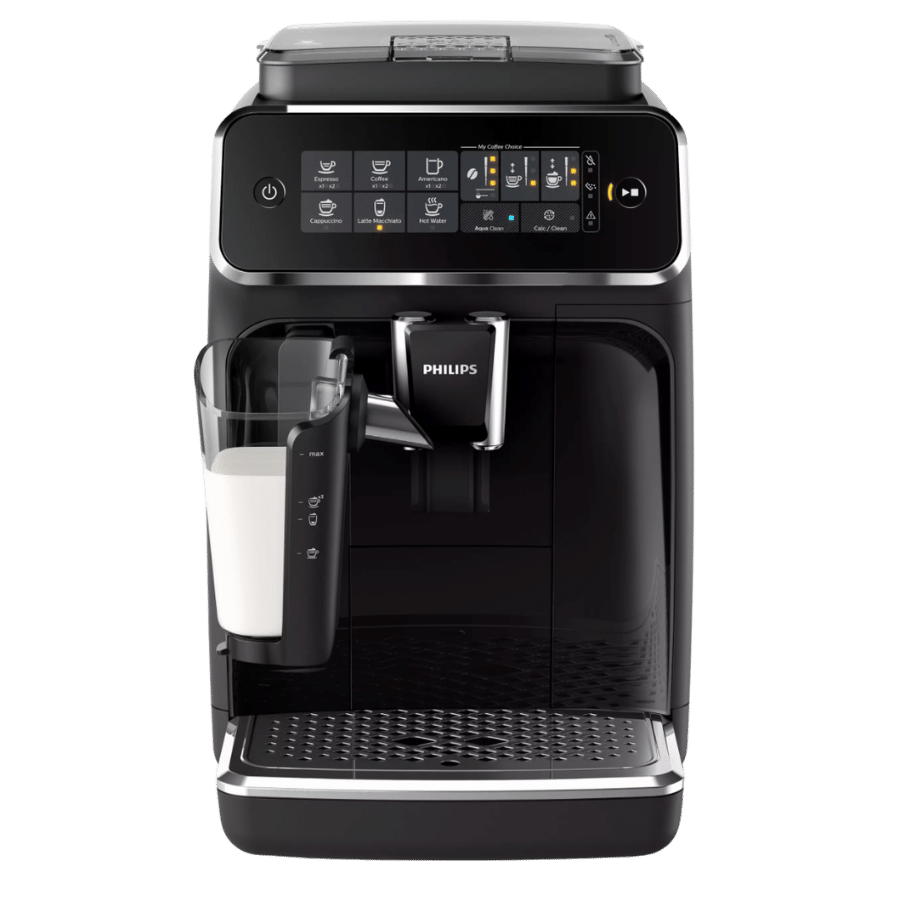
Philips 3200 LatteGo highlights:
- Fully automatic milk frother
- Easy to clean and maintain
- Brew 5 different types of coffee beverages
If you want a super-automatic espresso machine and a lower budget, the Philips 3200 is an excellent option. The front-loading system makes it easy to use — the water tank, drip tray, and coffee puck container are all accessible from the front and easy to maintain.
AquaClean water filter is another feature that makes the Philips 3200 easy to use. If you brew two cups a day, you’ll have to descale the espresso machine after 5,000 cups, which is about seven years.
This machine can make up to five different espresso drinks and hot water. You can choose which drink you want from the touch screen display. There are also some customization options — select your preferred strength and volume.
Phillips 3200 got its name from the LatteGo milk system. This is an automatic milk frothing system. There’s a carafe that you fill with milk and attach to the machine. Choose the froth level you want, press a button, and the machine will froth the milk for you and automatically pour it into your cup. There aren’t any tubes that you have to detach and clean. However, the frother only creates dense foam. There’s no microfoam for latte art.
Philips 3200 has a built-in ceramic flat burr grinder with 12 sizes. The grinder is high-quality and will last for years.
Read our full Philips 3200 LatteGo review, and our video review.
Pros
AquaClean filter for descaling after 5,000 cups
LatteGo automatic milk frothing
Ceramic grinder
Front-loading system
Cons
Only dense milk foam
Loud grinder
What’s the Best Espresso Machine for You?
My vote for the best espresso machine goes to Breville Barista Express Impress. It’s extremely user-friendly, affordable, compact, and, most importantly, creates quality espresso. Plus, it has a good steam wand, so you can work on latte art. This machine has everything you need to grow your barista skills at an affordable price.
If you’re just starting your espresso journey, check out our guide on how to use an espresso machine.

